|
|
Search for
The Famous Blonger Bros. |
|

August 2005
| 8/1/2005 |
Crime College
Six months prior to the Blonger Gang's arrest, this article appeared in the New York Times.
New York Times, March 31, 1922
Denver Crime College To Train 'Highbrow' Crooks
ORLANDO, Fla., March 30.—Confidence men are operating a college in Denver, Col., and issue diplomas to students who become proficient in the art, according to State's Attorney Jones of this city, who has just returned from Ft. Lauderdale, where he assisted in the prosecution of a dozen wiretappers.
One of the defendants at Ft. Lauderdale, 73 years of age, had been working all his life as a "second story" man, according to Mr. Jones, but two years ago attended the college in Denver, received a diploma as a confidence man, and the State's Attorney said, "is doing splendidly now in the highbrow phase of his calling."
The principal feature of the college curriculum was said to be a course in human nature.
There's yer movie right there. The article above was followed by this dispatch from Denver:
DENVER, Col., March 30.—If any college for the training of confidence men exists in Denver, as reported in a dispatch from Orlando, Fla., it has never come to the attention of the Police Department or the District Attorney's office, officials said today.
Lou's gang also worked in Florida, so it would not be surprising to learn one of the wiretappers was spilling the beans. Young Len Reamey later said that Lou's manager Adolph Duff would indeed conduct classes, and that he spent six weeks practicing cons without pay for bookmaker and teacher Jackie French.
|
| 8/2/2005 |
Score
And so brother Jeff and his son Matt get into the act. They hit the jackpot looking through the Denver papers that have been unavailable to us here in Illinois. How am I going to keep up?
This was published shortly after Lou's arrest:
Rocky Mountain News, August 26, 1922
Newspaper records of the history of the two Blongers in Denver are meager.
They reveal little of their activities. The police blotter, on the contrary,
is rich with accounts of the two men and their checkered careers.. First
entries were made about 1881. After that year they follow at irregular
intervals, reaching a climax in the 90's. One of the famous raids made by
the police on the ... tourist's club, 1740 Larimer Street operated by the
"Blonger boys" was that of Feb. 13, 1892. Both Lou and Sam, together with
men named Walker and Phour, were captured and charged with the robbery of C.
I. Tolly, a mining engineer and assayer of Longmont, Colo. Tolly had
complained to the police that he had come to Denver and had been discussing
a money transaction with a friend in the Markham hotel, when two men, who
had been listening, approached him and began talking of mining. On the
pretense of showing him some ore from Creede, they invited Tolly to walk
with them to Larimer Street. As they passed the Tourists club, the story
goes, one of the men asked Tolly if he would mind stepping in for a few
minutes. Tolly stood behind one of the men as they engaged with a some
others in a friendly game of poker. One of the men drew three aces and a
king and turning to Tolly asked him what he would bet on it. Tolly
reluctantly replied that if he were playing he would put $100 on it. The man
on the other side of the table made a pretense of taking the bet. Of course,
the aces and the king lost. The men then insisted that he pay, and when
Tolly attempted to escape they threatened his life if he did not sign over
the money. Tolly made out a check for $100 and went back to Longmont.
Friends urged him to return to Denver and complain to the police. His
complaint resulted in the raid.
Pretty thuggish, really, and adolescent. Not exactly the finessed orchestration of the big con.
The Tourists Club? Their first saloon was at 1644 Larimer, not 1740. This is something new.
And where do we find that police blotter?
This? Need we say more? (click it for a larger version)
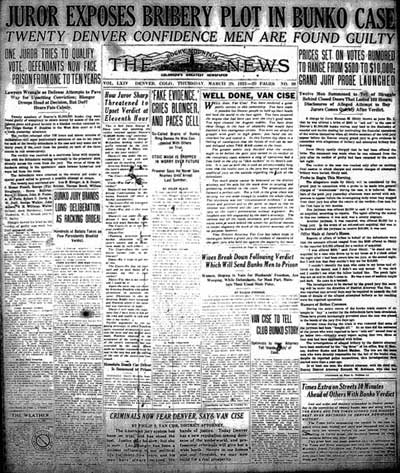
Coming: New (old) images of Lou Blonger.
|
| 8/3/2005 |
Maybe Jimmy Carter wasn't crazy after all...
Handy Jack Davidson comes through with a line on the old Denver city police blotter. Ask and you shall receive.
This note on Denver and its police force accompanies the online description of the collection:
Officially established by city charter in 1861. In 1891 a metropolitan police system was established under a board of commissioners appointed by the governor. In 1901 the department was returned to municipal control by the adoption of a home rule amendment.
Even this little tidbit moves us forward. Populist goveror Waite was elected in 1892. In 1894 he went to war with Denver city hall, obstensibly over the wholesale paroling of convicts through the Denver courts — the work of Denver's fixers, bigwigs in local gambling like Lou. Now we know that although the state Supreme Court eventually ruled in the Goveronor's favor, his hold on the Denver city police board only lasted until 1901.
My guess is that this event marks the point at which the Blonger Bros. became truly powerful in Denver, and I'd wager they exerted a lot of pressure to see that amendment passed. We'll see.
|
| 8/4/2005 |
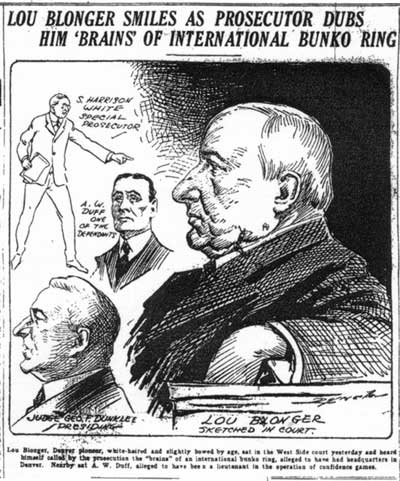
And more from the Rocky Mountain News; this time, a woman's viewpoint.
Rocky Mountain News, Feb. 8, 1923
Bunko Trial Might Give Many Pointers To Theatrical Director in Picking Cast
Every Type of Character Is Seen, Either Among Defendants, Prosecution or Spectators; Even Women 'Leads' Could Be Chosen From Crowd.
By Eileen O'Connor.
Abundant material for a casting director are the principals and spectators in the trial of twenty alleged "bunko" men in the West Side court this week.
It would take little or no stretch of the imagination to picture each and every one in a characteristic role in some drama, other than that they occupy in the alleged bunko ring and the prosecution. Even the feminine members of the production might be drawn from the scattering of the women spectators in the courtroom.
Seats in the courtroom were at a premium, with spectators eager to hear how gullible human nature can be get a "close up" of the victims.
All Classes Present.
The spectators are from every rank of life. Here and there is a proverbial "cake eater." In the front rows are some interested law students, now and again a prosperous business man saunters in from curiousity.
A large percentage of the spectators are the pool hall habitutes. From the number of them in the courtroom yesterday, it would appear that Thursday's business in these establishments suffered a decided "slump."
Feminine interest in the trial is not running high, judging from the half dozen - to place it high - women spectators yesterday. A sweet-faced, grayed-haired motherly type of woman occupied a front seat. Back of her sat a large, buxom woman of the landlady type. Her very appearance carried with it suggestions of constant contact with the world and hinted at ... in the trial thru a possible former "fleecing" out of board and room rent.
Jury In Contrast.
To the right of Judge George F. Dunklee sat the defendants. A striking contrast are they to the jury on the opposite side of the room. Young, for the most part, and well kept, especially "Yankee" Jack French; debonair and suave, they remind one of the wax figures which sit cool and collected, as they listen to their alleged activities thrashed out.
A little at the side and end of the line sat Lou Blonger, alleged "brains of the gang," looking more like a grandfather toasting his shins by the fireside than a defendant in a courtroom.
All through the afternoon, until relieved by a short recess, the trial was punctuated with dreary bickerings, harangues and conflicts of Special Prosecutors S. Harrison White and Harvey D. Riddle and a corps of attorneys for the defendants.
All Look Alike.
It would have taken at least a Philadelphia lawyer to distinguish attorneys from some of their clients when recess was called and they mingled togetther in the corridors of the building.
After that things moved fast and furious. When the curtain rose on the second act of the afternoon, Simon Oppenheimer, real estate man of New York, who barely escaped being relieved of $50,000 by the alleged "bunko" game was again the star witness. Cross-examined by Attorney R. D. Crump, his answers were so sharp and quick that they brought laughs from spectators and attorneys alike, until the bailiff was forced to rap time and again for order.
All too swiftly the minutes flew, as Oppenheimer, settling down in the witness chair and seemingly himself as at home and comfortable as if he were occupying his own parlor Morris chair, gazed into the barrage of eyes upon him and became not the least bit flustered at the attention being paid him.
Many Crane Necks.
Time and again necks of the spectators were almost craned out of joint to get a glimpse of the star witness. He proved most evasive under the corss-examining of Attorney Crump and staged a "vaudeville" show all of his own, as he quick-wittedly reverted back a majority of the attorney's questions, until it began to appear as if he were questioning Mr. Crump and not Mr. Crump him.
As the drama unfolds again today, Mr. Oppenheimer will again occupy the courtroom stage and continue his recital of how he almost parted with $50,000 to the alleged bunko gentry.
The trial promises to be a long, drawn-out affair and will continue to draw crowds, who want to hear how keen men lost their money to others just a little keener than themselves.
|
| 8/5/2005 |
Col. Van Cise
Correspondent and Denver lawyer Larry Reno calls our attention to the reason Col. Van Cise lost in his bid to continue as district attorney following his smashing success in arresting the Blonger gang: the rise of the KKK in Colorado, who would become a major force in Denver politics for years to come. Van Cise vigorously opposed the KKK, refusing their assistance as he had refused Lou's, and thus found himself deeply at odds with the organization.
Larry also says that his grandfather — a Denver detective — worked with our old friend, Detective Leonard DeLue. He keeps cropping up. In fact, I have several more articles on the man to transcribe.
On the subject of our other good buddy, RMN newshound Forbes Parkhill, Larry mentions that Phil represented the Rocky Mountain News prior to becoming DA. "This had so angered the owner of the Denver Post (Bonfils) that the Post would not print Van Cise's name. Probably the reason Phil didn't want the Post to have the scoop." Ha!
Rocky Mountain News, March 29, 1923
CRIMINALS NOW FEAR DENVER, SAYS VAN CISE
BY PHILIP S. VAN CISE
The American jury system has been on trial, and has stood the test.
Justice may be slow; but she is sure. Lou Blonger has been a sinister
influence in our political life for thirty-five years, and his men have
always escaped the hands of justice. Today Denver has a new reputation
among denizens of the underworld, and professional criminals will give
her a wide berth. Secure in our homes and our firesides, we may now
build for a real prosperity.
Times Extra on Streets 10 Minutes Ahead of Others with Bunko Verdict
Law and order and decency triumphed in Denver yesterday in the
conviction of twenty bunko men and along with it THE NEWS AND THE TIMES
SCORED THE BIGGEST BEAT EVER RECORDED IN DENVER NEWSPAPER HISTORY.
The Times extra announcing the verdict in the case in which every man,
woman and child was interested was on the street fully ten minutes
before its next nearest rival and was selling in Curtis street, the
territory nearest its rival, five minutes before any other paper.
This great beat was made possible thru the efficiency of The Times and
News employes and thru the courtesy of the Mountain States Telephone
and Telegraph company, which installed a short notice direct wire
running from the West Side court into the editorial offices and press
rooms of The News and The Times.
|
| 8/6/2005 |
Deneen, the Wonder Horse
Deneen, or Denin, was an imaginary horse used by the gang in Denver in fake horse race betting schemes. Never lost a race.
One afternoon at Eighteenth and California streets in Denver, he won three races in less than thirty minutes. He parlayed $1,000 into $92,000 almost as quick as you can say "confidence game." That was a typical performance for Deneen. Flying around the old Denham building racetrack, he was as beautiful a sight as you could hope to see.
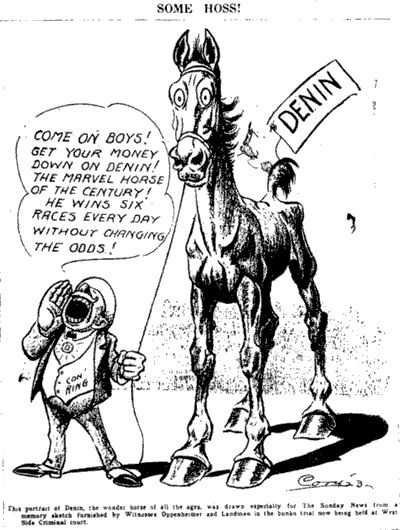
The caption reads: "This portrait of Denin, wonder horse of all the ages, was drawn especially for the Sunday News from a memory sketch furnished by Witnesses Oppenheimer and Landman in the bunko trial now being held at West Side Criminal court."
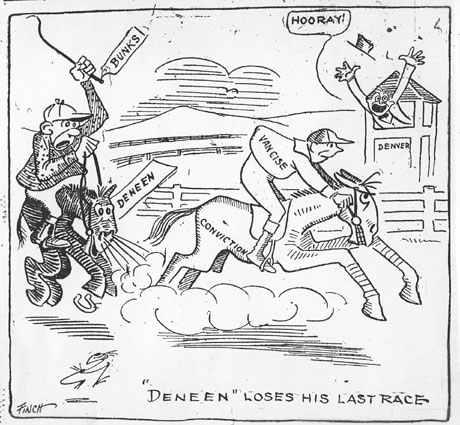
The Wire
A 1912 feature article from the Washington Post bemoans the passing of all the classic acts of crime, the "Dukes and Deans of the kingdom of Crookedness" such as the bank robber, the nimble catburglar, the deft safe cracker, counterfeiters and pickpockets. Increased security and police work made things tough for these professionals, but in their stead a whole new generation of dull-witted, coked-up thugs and petty thieves had arrived on the scene.
And yet, amongst the rabble, there was still the con man, who now stood at the top of the heap, the criminal's criminal. And of all the cons in play, the pick of the day was the wire con.
Known vaguely to the public as the "wire-tapping game," and its perpetrators called "wireless wire-tappers" in the news, to the con men it was simply the wire, played by "wire men," and executed in a "wire store." It was a hard con to prosecute even if a sucker complained to the cops, and the pay was good. But it was a big undertaking, and costly.
In the early days of telegraphy, it didn't take long to realize that a telegraph operator could easily withhold sporting results until confederates had placed a bet, and a few gangs made good money on this ploy for a few years. But by 1912, procedures were in place that made this impossible, so the grafters did the next best thing — they pretended they could delay the results, by having their own fake betting parlor where the results were posted late. There would be no actual betting taking place in this betting parlor, except for the mark himself. The rest would merely be for show.
The con often would begin with a newspaper personal seeking investors in a sure thing. Upon answering the advert, potential customers would be informed that the roper's cousin was quitting Western Union, and wanted to clean up before he went. He'd wait for a horse race where a longshot wins, and then hold up transmitting the results until bets could be placed on the horse.
To further entice, the sucker is introduced to the cousin in a fake telegraph office, and later a test wager is made in a private poolroom rigged up as a sports betting parlor. Of course, the longshot wins. Checking the afternoon paper, they see that the longshot was real, and did win.
The next day, the sucker returns with a wad of cash, ready to make a killing. When it comes time to make a phone call to get the day's winning longshot, the sucker is given the honor. On the other end of the line, the telegraph operator tells him to place his money on Name of Horse Here.
He does so, as does the roper at his side, but the horse comes in second. Later, they find the operator who tells them, "I said place, you idiot. You weren't supposed to bet to win! Place means second place!"
Strange as it may sound, suckers were known to have gone back for two or three more tries before the day was out.
Does this all sound familiar? Like it might make a good movie?
|
| 8/7/2005 |
Albuquerque Album
Today, a new gallery of photos. On our recent visit to New Mexico, we had the opportunity to peruse the photo collection at the Albuquerque Museum. The images we found were all taken in New Albuquerque, circa 1882.
|
| 8/9/2005 |
Lou's Death
Jeff dug up an article about Lou's impending memorial service at Colorado Clues. They have been gracious enough to put a link to this site on their homepage.
The article brings up a couple of curiosities.
The pallbearers will be old friends of the deceased, including comrades of the civil war period.
Might William Livingston, Lou's Civil War buddy and brother of Sam's first wife, have been there at the end?
Plans to push Blonger's Supreme court appeal and carry on his fight for vindication, even after his death, are being made by his attorney, it was said. If the appeal is carried on, it may enable fifteen others of the bunko ring to obtain the benefit of any decision that may be handed down in behalf of their former leader.
And there was a Supreme court case? State or federal?
|
| 8/10/2005 |
Made some improvements to the image collection, including the addition of a few pictures from our 2003 trip to Colorado (from Illinois).
Faithful Nola
We heard recently from Cindy Dale, a relative of Lou's second wife. Let's take a look at the woman who stood by Lou till the end.
Cora Morehouse was born around 1860, in Tallula, Illinois. Her father died when she was about 10. Her mother remarried and would later run a hotel with her new husband.
Van Cise said that in her youth Cora (known as Nola by the time she wed Lou) was a "successful variety actress, who was a high-class woman." It's possible her "performances" were of the type found in saloons and dance halls run by guys like Lou.
In 1889, Cora/Nola divorced her second husband William Lyons in Denver about the same time Lou divorced his first wife Emma. Lou and Nola were married later that year. Nola was 30; Lou was 40.
Lou was notoriously unfaithful to Nola, but when his death behind prison walls became inevitable, the couple reconciled and Lou transferred his fortune to Nola's name. Three months after Lou died, Nola married William McCauley. The couple lived in comfort at Denver's Cosmopolitan Hotel. Nola died in Denver in 1936, the year Van Cise published Fighting The Underworld.
Cindy's notes include a few things about Lou:
1870 census has him in Red Oak, Iowa with his parents, though to our knowledge Sam and he were with the Livingston family.
1875 census has him in Elko County, NV as a miner. We knew he was running saloons. That he was mining/prospecting as well comes as no surprise.
An 1890 Denver business listing for Blonger Bros., with offices on the Witter block.
1900 Denver census, Lou is a saloonkeeper.
1910, no job, no income.
1920, fruit farmer.
Lou's cherry orchards were indeed legendary; the pick of every crop went out by the bushel to his wide circle of friends. The orchard was deeded to Nola.
|
| 8/12/2005 |
In Lou Don't Trust
This one's rich. Jeff found this in the Rocky Mountain News. Run during Lou's trial, the ad warns that those who are offered a sweet deal on stocks — as was the case with many of the gang's victims — should talk to their banker!
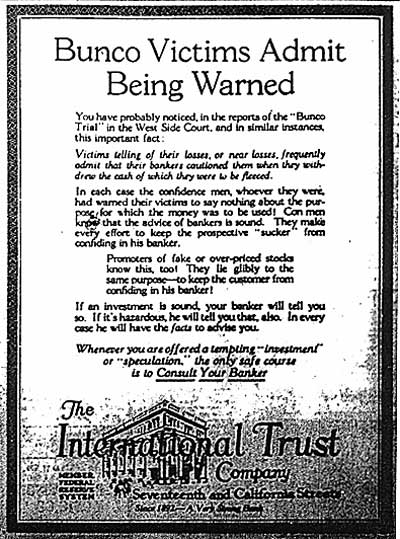
|
| 8/13/2005 |
The Mayor Gets His
Rocky Mountain News, March 27, 1923
OPEN LETTER TO MAYOR BAILEY
To Mayor Dewey C. Bailey:
Yesterday you caused to be printed in the paid advertising columns of the Denver papers an announcement of your candidacy for re-election as mayor of Denver.
In justice to the main prominent and law-abiding citizens whose names you caused to be printed in your paid ad you might give publicity to your views on certain things that at this minute are agitating Denver.
CAN YOU AND WILL YOU EXPLAIN your silence in the face of repeated sworn statements on the witness stand that the alleged bunko ring on trial in the West Side court was working under protection of your police department?
CAN YOU AND WILL YOU EXPLAIN why law-abiding citizens without prison records are thrown into jail on the least pretext and held there—in some cases allowed to die without medical care—while certain members of the alleged bunko ring, boasting long jail sentences, are given more consideration and treated with more courtesy by your personal appointees than could or would be commanded by highly respected citizens?
CAN YOU AND WILL YOU EXPLAIN why Tom Clarke, your deputy sheriff, was permitted to make honor guests of certain members of this alleged confidence gang and turn over to them a room in the West Side court building for the staging of a wild orgy, when in all justice they shoud be behind bars the same as any other alleged law violator awaiting decision of a jury?
CAN YOU AND WILL YOU EXPLAIN why your warden of the county jail made special arrangements for these same members of the alleged bunk ring, placing cots in the office of the jail for their comfort during the time they were in custody?
You are responsible to the people of Denver for the acts of your appointees, and if you are not willing to accept this responsibility you have no right to be mayor of Denver.
The attitude of your administration thruout the trial of the alleged bunko ring has been one of opposition toward the district attorney and the special prosecutors and one of protection and condolence toward the accused men.
Denver's fair name is at stake. The open operations of an international bunko ring in Denver is a paramount issue in the coming city election. If you are to be a candidate for re-election, the people of Denver demand to know and have a right to know where you stand on this question.
A CITIZEN AND A TAXPAYER
|
| 8/14/2005 |
The NY Times
New York Times, August 25, 1922
BUNKO TRUST BROKEN WHEN ARRESTS MADE
Denver Florida Gang Is Broken Up by 33 Arrests Today.
A FAKE EXCHANGE
Two Wealthy Men Owning Property Are the Brains.
DENVER, Aug. 25.—With the arrest here of 33 alleged confidence men the district attorney's office believes that the famous national "bunco trust" has been broken up. The gang had maintained elaborate offices here and swindled victims out of hundreds of thousands of dollars. The group were known as the Florida gang. Victims of the gang were chiefly members of the tourist class possessed of considerable money, who were fleeced by means of a fake stock exchange. The roundup just completed came after an investigation, during which $15,000 were expended. The money had been advanced by several prominent business men in Denver. Loub Longer [sic] and Adolph Duff, both wealthy men and owning property in Denver, are alleged to be the "brains" of the organization. Charges against members of the gang will be made today. The formal charge to be filed will be that of "conspiracy to commit a confidence game." It is alleged that members of the ring have jumped their bonds in other cities. The bonds have ranged upward as high as $50,000 cash. The ring is also alleged to have offered bribes as high as $25,000 to secure the release of other members of the gang arrested and placed in jail in Los Angeles, Calif., several years ago.
Charges against the 33 men will be made formally this afternoon and the prisoners will be permitted to arrange for bond. A systematic roundup is under way with headquarters in the First Universalist Church. The prisoners are taken to the basement of the church, which serves as a temporary jail.
|
| 8/15/2005 |
The Blonger Blotter, Part I
We published part of an article here recently that discussed the Blongers' criminal record prior to Lou's arrest. Here's the whole article. It goes a long way toward outlining the types of crime in which Sam and Lou were involved during their Denver heyday — things that were kept from the papers. It also highlights the common criminality of most swindles, far from the quaint wordplay and ingenious ploys we may romantically associate with the con man.
Rocky Mountain News, August 26, 1922
RECORDS REVEAL BLONGER IS USED TO BEING JAILED
Aged Alleged Czar of Swindlers Arrested Scores of Times, but Never Convicted, Police Blotter Shows.
BY DEANE H. DICKASON
Wiseacres in police circles say that an arrest, more or less, in the life of Lou H. Blonger, means little or next to nothing to the alleged "czar" of Denver's "bunco" firmament, who was seized in Denver's alleged "swindle game" raid yesterday. In his 73 years, more than forty of which have been passed as a "sportsman" in Denver, he has been in and out of jail more than a score of times, police records show. In no instance, however, has be been convicted of the numerous, larceny, robbery and "confidence game" charges that has been lodged against him.
Inevitably he has escaped, usually without a trial. When he has faced a jury the judge has asked for a directed verdict on the grounds of "insufficient evidence".
Powerful influences and valuable connections, police say, have had their part in the Blonger drama in the past, more especially on that day when Lou was working with his older brother Sam, who died Feb. 15, 1914.
Same Forces At Work, Is Rumor.
Rumors already are afloat that these same, or similar, interests and connections are waging a telling battle for the aged man's exoneration of the charge "conspiracy to commit the crime of confidence game." The information was filed against Blonger and his thirty-three alleged confederates yesterday afternoon by District Attorney Philip S. Van Cise. Judge Warren A. Hagsott, in the district court, set their bail at $25,000 each.
A few minutes later Blonger was a free man. His bond was given by Mr. R. ("Red") Gallagher, well known in Denver sport circles.
Altho he had been incarcerated less than eighteen hours, he came out of jail a different man from when he entered soon after midnight yesterday morning. His health which, according to his wife, has been failing rapidly in recent months, appeared to have withered under his close confinement. He was pale and jaded.
Before hastening out to his cherry ranch in the Lakewood district, he found occasion to deny most vehemently the charge against him. He declared that it was without foundation, and according to his attorney, "without rhyme or reason."
Police Blotter Reveals History.
He did not return to his house, 1541 Grant street, last night, nor was he believed to be at his ranch. He telephoned his wife shortly after his release that he would not be home all night. Friends, who are familiar with his physical condition remarked that he might have gone to a local hospital to rest up after his sudden confinement.
Newspaper records of the history of the two Blongers in Denver are meager. They reveal little of their activities.
The police blotter, on the contrary, is rich with accounts of the two men and their checkered careers. First entries were made about 1881. After that year they follow at irregular intervals, reaching a climax in the 90's. One of the famous raids made by the police on the ... tourist's club, 1740 Larimer Street operated by the "Blonger boys" was that of Feb. 13, 1892.
Engineer Trapped in Bet.
Both Lou and Sam, together with men named Walker and Phour, were captured and charged with the robbery of C. I. Tolly, a mining engineer and assayer of Longmont, Colo. Tolly had complained to the police that he had come to Denver and had been discussing a money transaction with a friend in the Markham hotel, when two men, who had been listening, approached him and began talking of mining. On the pretense of showing him some ore from Creede, they invited Tolly to walk with them to Larimer Street.
As they passed the Tourists club, the story goes, one of the men asked Tolly if he would mind stepping in for a few minutes. Tolly stood behind one of the men as they engaged with a some others in a friendly game of poker. One of the men drew three aces and a king and turning to Tolly asked him what he would bet on it. Tolly reluctantly replied that if he were playing he would put $100 on it.
The man on the other side of the table made a pretense of taking the bet. Of course, the aces and the king lost. The men then insisted that he pay, and when Tolly attempted to escape they threatened his life if he did not sign over the money. Tolly made out a check for $100 and went back to Longmont. Friends urged him to return to Denver and complain to the police. His complaint resulted in the raid.
Youths Were Victims in Gaming.
The Blongers protested their innocence and lack of evidence resulted in the case being dismissed.
Less than three months thereafter, on May 7, 1892, the fire and police board closed up the Blonger brothers' gambling house, 1744 Larimer street. The reason given at the time was that a "systematic bunco game was carried on, the victims of which were chiefly young men of tender years."
Not long thereafter the brothers opened up a saloon on Market street between Sixteenth and Seventeenth streets. This gained such ill repute that in 1895 a campaign was launched against the resort by the Mercury, a weekly publication of that period.
The records do not reveal that this was successful, for the regular complaints of larceny and "confidence games" continued up till as late as the early part of the century.
On July 1, 1901, Lou Blonger was arrested on a charge of obtaining money by gambling devices. He admitted that he had won $250 from G. Ritter and F. Breckner, the complainants, in a room in the Good block. Blonger, however, supplemented his admission with the statement that the money was won on the square and that the foreigners should have no complaint.
Millionaire Caused Arrest.
Blonger immediately gave bonds for his appearance and was released. Ritter, it later developed, was a millionaire hotel man, and as soon as Blonger returned the money to him he took a train for San Francisco, bound for Japan. When the case came to trial there were no complaining witnesses and Blonger was free.
Fifteen days later, July 16, 1901, Detective Delaney charged Blonger with bilking an English tourist, also named Ritter - Henry Ritter - of $375 in a game of brace poker. The case was dismissed.
Blonger's many ups and downs with the police department, according to old heads at the station, achieved their denouement July 1, 1898, when the "sportsman" was arrested on an assault and battery charge after he was alleged to have been "buncoed" of $1,000 by C. M. Fagen Bush and J. A. Weaver. In addition to having the men arrested on a grand larceny charge, he is alleged to have beaten Weaver with the butt of a revolver. Weaver filed the assault and battery complaint.
By this deal with Bush and Weaver, according to the story Blonger related to the police, he was offered a proposition to purchase $3,000 worth of mining stock held by a third person. Blonger advanced $1,000 of the purchase money, but when he called to get the stock he was told that his check had been taken by a third person and they had all lost their deposits. Blonger then is alleged to have become angry and to have struck Weaver.
Blonger "Buncoed" is Prize Joke.
The story of his appearance at the police station following this incident as it appeared in the The Rocky Mountain News, July 2, 1898, still is read with a chuckle in police circles.
"It was the spice of a decade," one of the old boys said yesterday, as he recalled the article, which, in part, reads as follows:
"Lou Blonger has been buncoed. This is about the most startling piece of news the police department has received in a long time. It was not hard work to find it, either, as Blonger 'yelled' louder than the backwoodsman from Indiana who bought the gold brick. It was a long time before Blonger could induce the detectives to take the 'yell' seriously.
"Yesterday evening Blonger appeared at police station much excited and exclaimed that he had been buncoed. All the detectives were taken with a fit of laughter. Their mouths stretched and their sides shook. Tears rolled down their cheeks and it was fifteen minutes before they could compose themselves. They were listening to Blonger's tale of woe.
"Blonger has the reputation of being a bunco man himself and for years had everything his own way on lower Seventeenth street, where he successfully managed a gang of the shrewdest confidence men in the country. This was the reason the detectives laughed so heartily when Blonger said he was buncoed."
|
| 8/16/2005 |
The Blonger Blotter, Part II
We first met Lou Blonger courtesy of the Colonel. Even before we received our copies of Fighting the Underworld we were vaguely familiar with the story, primarily because most of what's been written about Lou is based on Van Cise's tale, including the AmericanMafia.com page that first told us what happened to long-lost little Louis Belonger.
Van Cise taught us about the affable old Fixer of Denver, getting rich off the bunko artists he protected and sticking his finger into Denver politics at every turn, always himself protected by his many powerful friends in business and government.
But Van Cise was not particularly knowledgeable about Lou's activities prior to 1921. The Colonel engages in a cursory discussion of Lou's origins, and his early days in Denver. He gives us a reasonably detailed picture of the Fixer at the height of his power. But how did he get there? How does one become a Fixer?
Then, of course, we struck paydirt in Albuquerque, where the newspapers in 1882 had plenty to say about Sam and Lou, and even Joe. We found that Sam and Lou were not only deputy sheriffs and marshals in that city, but later private detectives as well.
We also found reason to believe they had ties to organized bunko activities as early as 1882. Before that? Most likely, but the evidence isn't there. Since the late 1860s they'd been running saloons, theaters, brothels and gambling joints, and living the life of the professional gambler. To assume they were slow to the con would be ludicrous — but we go with the evidence.
Our knowledge of the period between 1882 and 1922 has been sorely lacking too, but recent research is giving us a clearer picture, particularly concerning the Blongers' career in crime.
And then there's yesterday's article.
Here's what we already knew about the Blongers' criminal record, 1882-1922:
1882: Lou cashes a check for Ben Meyer, who promptly loses half of it in a game of stud poker. Claiming he'd been swindled (good guess), he goes to the bank and orders payment stopped on the check, claiming that it had been stolen. Lou brings suit against Meyer for the amount of the check. He is expected to win the case.
1895: Soapy Smith, recently returned from Creede, rampages through town with his brother Bascomb in an attempt to intimidate the Blonger Bros. and restore his control over the lucrative bunco racket. Smith is nearly shot by Lou as he enters the Blonger's saloon, but is convinced to leave by the local cops. An assault committed that night would soon force Smith to leave Denver forever or face prosecution.
1898: A small-timer named John Weaver cons Lou into writing him a check for $1000. Later, Weaver refuses to give it back. Lou cries bunco and sues the guy, but Lou's reputation is already so well-established that the cops and the press all have a good laugh. But Weaver probably never worked in Denver again.
1901: Lou is tried for allegedly cheating an englishman out of $300 at cards, even though the victim admitted losing on a hand he dealt himself.
1910: Van Cise says in Fighting The Underworld that Lou managed to evade implication in the federal trial of Council Bluff, Iowa's Mabray Gang of big store operators. The Colonel tells us Lou accomplished this feat through the timely intervention of an unnamed lawyer, partner of a United States District Attorney, and his anonymous companion, a United States Marshal.
1915: A British army officer, in Denver to buy mules and horses for the war effort, loses $90,000 playing the wire, a wire-tapping scheme like that portrayed in The Sting. He thought he was betting on a horse that had already won. Lou is implicated by papers found in the suite of offices used in the con.
Now let's look at the new statements from the Rocky Mountain News:
1881: One or both were first arrested in Denver in 1881. We already knew they had been in the Denver/Leadville area since 1879, but by early 1882 Sam would be marshal of New Albuquerque and Lou his deputy.
1892: Sam and Lou are arrested at their saloon, the Tourists Club, for swindling C.I. Tolly out of $100 and threatening him when he refused to pay.
1892: Blonger brothers' gambling house at 1744 Larimer street closed by the fire and police board. Not long after, the brothers open a saloon on Market street between Sixteenth and Seventeenth streets.
1895: Mercury, a weekly publication of the period, launches a campaign against the Blonger Bros.' saloon.
Not bad for one article. Now, where's that Mercury?
|
| 8/17/2005 |
Charlie Ronan
As a neophyte researcher, I have learned that many times a name that means nothing to you on first reading will take on new dimensions as you run into the same person again and again, and soon you find yourself revisiting materials to find the pieces of the story you ignored on the first pass.
Enter Charlie Ronan. We met Mr. Ronan a while ago, while reading of Sam's Albuquerque exploits. As Sam's deputy, he is mentioned in two notable cases from 1882, the Shootout on Railroad Avenue, and Griffin's Run.
In the first incident, Sam, Lou and Charlie are fired upon by two drunken bartenders. The three return fire, chasing the mixologists through a raging sandstorm (so the story goes) to no avail. The men were arrested the next day.
A month later, Winslow, AZ dance hall owner Griffin tries to run out on his creditors, but is apprehended in Albuquerque by Sam's posse, including Lou, Charlie, and Judge Dan Sullivan. Griffin has three loaded pistols at the ready, but not the nerve to use them.
So, we knew of Charlie, but not much of him. While in Albuquerque, we believe we discovered his personal claim to fame. As such he will be the newest member of the Grafters Club, joining another of Sam's deputies, by the way, Cornelio Murphy, who was inducted in a private ceremony a few days ago, along with Lou's Civil War buddy William Livingston.
This story takes place shortly before the beginning of Sam's tenure as marshal.
Albuquerque Daily Journal, December 13, 1881
EGAN'S ETERNITY.
John Egan Comes to Albuquerque to Meet His Death.
The Tragic Ending of a Would-be Bad Man Last Night.
John Eagan boarded the Pacific express at Wallace last night with a ticket for Albuquerque. He was under the influence of liquor, and was continually making gun plays on the train. He picked a quarrel with a gentleman who was on his way to El Paso, and drew his revolver, but was kept from firing by a third person. He also attempted to shoot the brakeman, but without success. He was apparently bent upon shooting some one, and was not very particular about who it was.
When the train reached here he got off the car and started towards town. Suddenly three shots were fired,and then there came another. The platform at the depot was crowded with people, and although the shots were fired right in the crowd nobody knew who did the shooting. Eagan fell with a bullet through his heart, and died without uttering a word.
Who shot him was a mystery to all, and even those who stood right at the side of Egan when he fell could not give any rational account of the tragedy. A dozen stories were circulated as to how it was done. Judge Sullivan took charge of the body, and it was removed to Robbins & Torrey's undertaking shop. It was decided to postpone the inquest until to-day, and the crowd dispersed.
The JOURNAL reporter then commenced to make inquiries with a view to learning who it was that fired the fatal shot. After considerable rustling he discovered that Charles Ronan was the man. He made the following statement as to the manner in which it occurred:
"Scott Moore and myself were walking through the train when I remarked to him 'the whole gang is in there.' A man who was sitting near heard the remark and followed me to the door, and said, 'are you one of those fellows looking for the hold-ups?' and I told him I was not, that I was merely talking to my friend in the train. By this time we had reached the platform. He then said, 'you don't want to say anything more on this platform or I'll give it to you,' and then after a moment he continued, 'I'll give it to you any way,' and suiting his action to the word he drew his revolver and fired. I jumped aside and pulled my pistol, and when he fired again I fired. He fell just as he fired the third shot. I never saw the man before and I don't think he ever saw me."
Ronan turned himself over to the officers and is now in their custody. He will have a hearing this morning at 9 o'clock.
The reporter now made it his business to learn something of Eagan. [Start with how how to spell his name.] The only man who knew anything about him suddenly disappeared after the killing, but he was finally found in room thirteen at the Hotel Maden, where he had retired for the night. The newspaper man was admitted to the room and learned that his name was Henry Kehoe, and that he was a chum of John Eagan. He and Eagan are miners, and have recently been employed by Cañon del Agua company at San Pedro. Kehoe knows nothing whatever of the circumstances of the shooting. He said that Eagan was a quiet, inoffensive man when he was sober, but that he had been drinking hard that day and was very drunk when he went on the cars. He did not see any of Eagan's movements on the train, as he was in another coach. Of the history of the dead man comparatively little could be learned. He came west in 1861 and has parents living somewhere in Illinois. He belongs to the order of the Odd Fellows. Kehoe has sixty-four dollars belonging to Eagan, and will see that he has a decent burial.
Charlie Ronan has always borne a good character in this community, and there is not the slightest doubt that he was justified in his act.
Albuquerque Daily Journal, December 14, 1881
Charlie Ronan had his examination in Judge Sullivan's court yesterday morning, and was discharged, as the evidence showed that he acted in self-defense.
Albuquerque Daily Journal, December 15, 1881
Charlie Ronan, who killed John Eagan Monday night, was formerly of Leavenworth, Kansas. He came west to Dodge City seven or eight years ago, and then drifted into New Mexico. Ne is chiefly noted in New Mexico as a remarkably good billiard player.
The Chinaman who runs the hop joint guards his place every night with a double-barreled shot-gun. It is not safe for anyone to attempt any harm to the establishment, if he does not desire to be perforated with buck shot.
Mary Blonger
Scott's found Mary Blonger's death certificate. Mary was youngest brother Marvin's wife, and she died March 7, 1897. Marvin spent his adult years mining in Montana.
|
| 8/18/2005 |
The Mercury
Here we go again. There's more to the Mercury than meets the eye. As was recently quoted here:
...the brothers opened up a saloon on Market street between Sixteenth and Seventeenth streets. This gained such ill repute that in 1895 a campaign was launched against the resort by the Mercury, a weekly publication of that period.
Obviously, we knew we had to find the Mercury articles. But the plot thickens. An online article on Nat L. Baker tell us:
He took up his residence in Denver and is at this time editor of the Sunday Mercury, a paper devoted to the upbuilding of the populist party and the official organ of Governor Waite.
Populist Gov. Waite, as you will remember, was elected in 1892, and by 1894 had declared all-out war against the Denver gambling fraternity and their cronies at city hall. And by war, I mean gatling guns, cannons, mounted troops — though no shots were fired. The Denver machine had fortified city hall, including a quantity of dynamite, and manned it with an army of "special police" newly deputized for the occasion. The militia made no advance, and the supreme court eventually settled the matter.
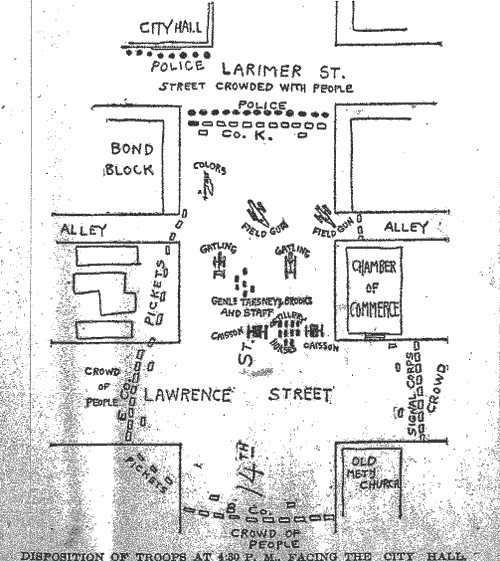
In 1894 the gambling joints were all closed down by Waite's new chief of police, fellow populist Hamilton Armstrong. Not for long, probably.
Charlie Ronan
|
| 8/19/2005 |
The Mercury
And stranger still...
So Nat Baker, editor of the Mercury, was the tool of the populist governor who detested the vice merchants and gamblers — and a backer of Soapy Smith? What's going on here? Either way, he'd have reason to give the Blongers a hard time...
|
| 8/21/2005 |
The Mystery of 1881
What do we know?
1879: Sam ran for mayor of Leadville (March), and Lou ran a theater (November) not far away in Georgetown.
1880: Sam Blonger (with wife Ella and son Frank) is listed in the federal census of Denver. Sam and Lou Blonger are listed in the federal census of Leadville. Their lives in Leadville and Denver seem interchangeable at this point. Both Fighting The Underworld and Hustlers And Con Men have the Blonger Bros. first setting up shop in Denver in 1880.
On the other hand, we know with absolute certainty that they spent a great deal of time in Albuquerque in 1882.
But what about 1881?
In Lou's service pension file, he wrote that he was in Leadville until 81, after which he moved to Albuquerque.
Then again, when he arrived in Albuquerque in February of 1882, the reporter was told that he was "visiting from Texas." In later years Lou told stories of his days as sheriff of San Angelo, but when else might he have spent time there? Prior to 1879, Sam and Lou were plenty busy in Utah and Nevada. Between 1883 and 1887, perhaps, though Lou claimed to have lived in southwestern New Mexico during all that time.
And then there's the railroad. Obits had them helping build the Denver & Rio Grande in some capacity, and we had thought 1881 would be a good candidate based on the Southwest location and the railroad expansion of that timeframe. But who knows?
Recently, an article written in 1912 revealed that Lou was first detained by the Denver cops sometime in 1881.
Might their southwestern adventure have been a way of laying low?
|
| 8/22/2005 |
Fegenbush
One of the most memorable moments in Lou Blonger's life came in 1898 when he walked into a police station and told the cops he'd been buncoed. The cops had a good laugh, as did the newspapers.
John Weaver had approached Lou, wanting seed money to pull a con. Lou obliged, but the con never materialized, and neither did his money. Also involved were C. A. Waldo, and Charles M. Fagen Bush.
Well, Scott went nosing around for Mr. Fagan Bush, or Fegenbush, and guess what?
New York Times, June 24, 1897: Fegenbush is picked up for an outstanding Denver warrant for forgery. Police find he is in the midst of a scheme, with three secretaries busily typing letters on fake letterhead to various businesses. The letters are meant to make the recipient believe he is about to come into possession — mistakenly — of a valuable watch, and that he will only need to pay $2.50 to the postman to get away with it. The box, however, when opened would only contain salt and a cheap toy watch.
New York Times, June 30, 1897: It is revealed that Fegenbush is also "badly wanted" in Montana.
Washington Post, October 22, 1900: Fegenbush and Harry DuBois are arrested for a wire scheme they pulled in Chicago: three marks, ten grand.
New York Times, November 22, 1900: Fegenbush and Harry DuBois are arrested on the Chicago charges, again, this time in New York. Must have jumped bond. Cost of doing business.
Chicago Daily Tribune, February 19, 1901: Fegenbush and DuBois busted for a mining stock swindle.
|
| 8/23/2005 |
J. Frank Norfleet
Tonight, an article about the manhunt undertaken by a retired Texas farmer after he was swindled, twice, for a total of $45,000. Norfleet spent two years hounding the Furey gang, until the trail finally led to Denver, and Van Cise, whose investigation was already underway.
|
| 8/24/2005 |
Bat Masterson
Scott got a booklet today titled Doc Holliday, Bat Masterson and Wyatt Earp: Their Colorado Careers, published in 1974 by E. Richard Churchill. There will be more to say, but for the moment, this:
By the close of the 1880s Bat had all but forsaken the life of the gun slinging lawman in favor of more peaceful pursuits. Though Bat numbered among his friends such as underworld czar Lou Blonger and his huge, but stupid brother Sam, Bat's gun was not for hire save as a peace keeping device where he was employed.
Stupid? That does not fit my mental image at all. What's his source?
Worse yet, "huge, but stupid?" What does that mean?
Denver Directory
From Jeff, some miscellany from the Denver city directories. During this particular period the boys were in the process of taking control.
1893:
- Blonger Bros (S H and L H), Club rooms, 1744 Larimer
- Blonger Fred, clk Garson, Kerngood & Co, r 2731 California.
- Blonger Louis H (Blonger Bros), r 1740 Arapahoe.
- Blonger Sadie Mrs (Jones & Blonger), r 2, 835 18th.
- Blonger Samuel H (Blonger Bros), r 2, 835 18th.
- Blonger Simon R, miner, 2731 California.
1894:
- no listings!
1895:
- Blonger Bros, mining, 1644 Larimer.
- Blonger Frederick L, clk Garson, Kerngood & Co, b 828 Clifton av.
- Blonger Louis H (Blonger Bros), r 1761 Ogden.
- Blonger Samuel H, saloon, 1644 Larimer, r 2018 Ogden.
- Blonger Simon R, miner, 1644 Larimer.
and in the business section under Saloons:
- BLONGER S H, 1644 Larimer.
1896:
- Blonger Bros, mining, 1644 Larimer.
- Blonger Frederick L, clk, r 828 Clifton av.
- Blonger Louis H (Blonger Bros), r 1761 Ogden.
- BLONGER SAMUEL H, saloon, 1644 Larimer, r 2018 Ogden.
and in the business section under Saloons:
- BLONGER SAMUEL H, 1626 Stout.
1897:
- Blonger Fred L, clk Denver Dry Gds Co, r 2708 Marion.
- Blonger Louis H, miner, r 1761 Ogden.
- Blonger Samuel H, r 2018 Ogden.
|
| 8/25/2005 |
Fegenbush & Dubois
Fegenbush and Harry Dubois were evidently quite a team around the turn of the Nineteenth Century. The series of events described here recently were recapped in a 1901 article following their arrest on Denver stock fraud charges.
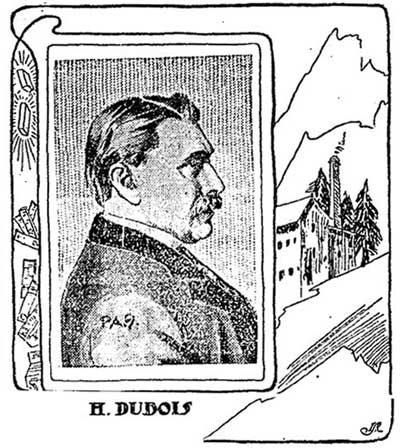

Chicago Daily Tribune, May 12, 1901
Harry Dubois, arrested by detectives Halpin and Hogan while he was endeavoring to dispose of some shares in a bogus mine to Bernard Berlizheimer, 457 La Salle avenue, will have a hearing on May 17. Tomorrow the detectives will go before Judge Smith and request him to forfeit, on a previous case, Dubois' bond of $4000 and begin the prosecution of the bondsmen, one of whom is missing, while the other is reported to be dead. The city was searched yesterday for some trace of "Barrett," who was reported to be operating with Dubois in the deal with Belizheimer, but no clew to his whereabouts was learned. Dubois is considered by Detective Halpin to be one of the most dangerous confidence men in the country. Last September he disposed of 60,000 shares in the Ward Consolidated Gold Mining company to Mrs. Laura G. Fixen, 430 La Salle avenue, obtaining $3,000 from her. She discovered the shares were worthless and notified the police. Dubois and Charles M. Fegenbush were arrested as fugitives from justice in Washington, D. C., on suspicion of being the offenders. Detective Halpin went after them, but the prisoners were released before the papers arrived, the Judge informing the officer that "the proper way to do business is to have your papers on the grounds when an arrest is made." Halpin returned home disgusted, but was relieved three weeks later to receive word announcing the arrest of the men in New York. This time he was successful in securing them. They were brought back to Chicago and released on bond. Fegenbush decamped, but Dubois remained and appeared in court. He was permitted to go free on the same bond and followed his partner out of town. Since then the Chicago police have been looking for him. Dubois recently fleeced Warren Springer out of $8,000 on mining shares. In the Berlizheimer deal, which he was negotiating, he offered shares in the Basil Duke mine, which he guaranteed would advance from 20 cents to a price that would net a good profit, as a valuable vein had been discovered. George H. Dubois, or Harry Dubois, as he is known from New York to San Francisco, is 39 years old. He is 5 feet 7¾ inches in height, and weighs 167 pounds. He has operated under the names of Dubois, Wilson, William Davidson, H. L. Adams, and W. F. Harris.
In September of 1901, the Chicago Daily Tribune reported that Chicago chief of detectives Capt. Colleran was under investigation for allegedly sabotaging the arrests of several Chicago fugitives, including Fegenbush, by destroying evidence and stalling the necessary paperwork.
An article from 1897 has Fegenbush getting the New York chief of detectives O'Brien in trouble for the same thing.
In January of 1902, Fegenbush is arrested yet again on the Chicago charge, bilking a woman out of $3000, and brought back to Chicago.
|
| 8/26/2005 |
New Lou
Lou at the time of the trial:
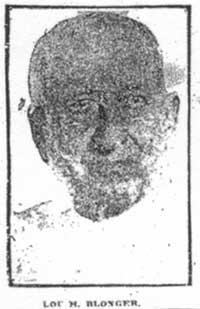
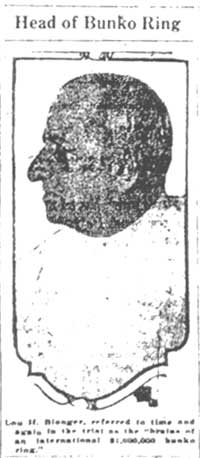
The naming of Deneen
Denver Post, February 18, 1923
Ancestry of 'Deneen' Revealed at Last!
Miracle of Track Named for Governor of Illinois Who Pardoned Bunco Men
A sensational discovery which will go down in history along with Lord Carnarvon's ferreting out of the last hiding place of King Tutankhamen, was announced Saturday by Attorney [Charles] A. Irwin of Colonel Van Cise's private legal staff.
"Deneen's" ancestry was revealed. Delving patiently and persistently into the murky, muddy, moneyed mysteries of the past, the legal archeologist penetrated the bunkological barriers and uncovered the fragile, dust-covered papyrus on which was chiseled the family tree of the princely nag.
"Deneen" was sired by Executive Clemency. His dam was gratitude. Sucker was his great sire on his father's side of the house and Confidence was his great dam on the maternal side.
"Deneen," Attorney Irwin revealed, was named for Ex-Governor [Charles] Deneen of Illinois. According to the discoveries made by Irwin in his excavations in the Bunco Catacombs, many years ago Governor Deneen pardoned from the Illinois penitentiary a "con man," who later became a member of the Denver bunco ring.
In gratitude for the executive clemency extended their brother wolf, the "buncs" voted unanimously that so long as a sucker lived, the name of Deneen should not be forgotten. No ordinary honor could express their gratitude, so they bestowed upon the bunco colt, born of Executive Clemency and Gratitude, the name of "Deneen."
And be it said to "Deneen's" credit, he never lost a race. Every time he went to the post his backer thrilled to the cry: "'Deneen' WINS!"
|
| 8/27/2005 |
Los Cerrillos
We recently received some additional materials from Bill Baxter, photocopied pages from The Cerrillos Mines and Their Mineral Resources. A Description of the Mines in the Los Cerrillos and Galisteo Mining Districts, Accompanied by a Map of the Same, Drawn from Actual Surveys., J. Lyman Hayward, 1880. Included are the pages that mention Joe and the claims he owned or worked, but as the book was published in '80, Joe and his fellow white miners had only been there about a year, give or take, so the data Bill supplied previously is more complete.
What's more interesting is what the book says about this mining area in New Mexico, and further, what Bill says about what the book says.
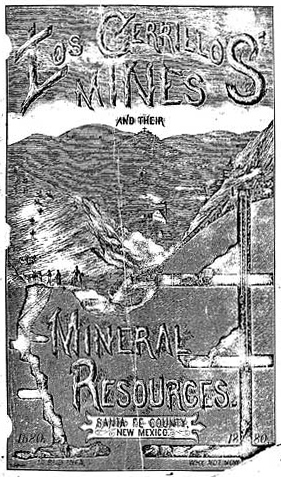
Hayward describes the area, noting that from a distance they resemble a cluster of anthills on the plain south of Santa Fe. And so they do.
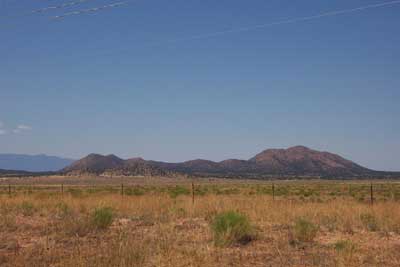
He also notes that the hills had been mined for centuries — by the Pueblo for tourquoise, and later the Spanish. When the native population revolted against the Spanish in 1680, many of the mines were filled and hidden to keep them from the Spanish.
Indeed, one of our first finds was an article describing the old stone tools found by Joe and his partner Whalen at the bottom of the Bottom Dollar mine, buried there since 1680.
Hayward describes the rock slide that occured at the Chalchuitl tourquoise mine, killing some twenty-five indian workers in 1680. The Spaniards attempted to press more workers into service at a local town, but the locals revolted, driving the Spanish from the area for a time.
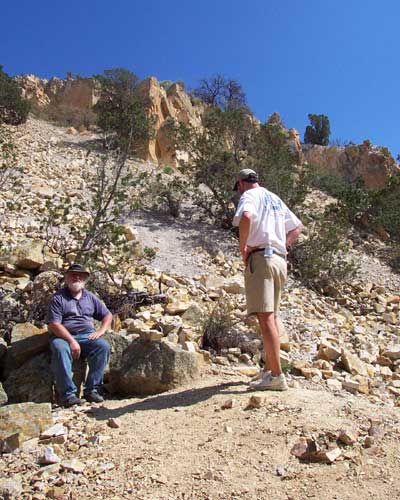
In naming the various camps of the district — Dimick's Camp, Poverty Hollow, Bonanza City, Cerrillos Station — one name stands out: Purdin's Camp.
Joe was partner with, I assume, this same Purdin in the Agricultural, the Badger, Little Joe, Purdin, Sunny Slope, Union, Vulture and Washington, at least.
And why, according to Hayward, had the Cerrillos area been of no interest to the American capitalist until now?
The answer is simple: New Mexico is populated by a race whom we have been taught to look upon as robbers, and in fact all that is bad. A prospector would naturally look for new discoveries in a country which is not very thickly peopled, consequently the more northern states and territories have been more extensively prospected. The Indians have been troublesome for many years in the territory, and reports (oftentimes greatly exaggerated) of the dangers to which life and property are exposed, have been circulated in many newspapers, thus deterring many from visiting the territory. Then again the remoteness from all communication with the East has been a drawback. Today the real and fancied objections have been removed. The natives of New Mexico are of a kind and generous disposition. They never molest or interfere with a person or his business. Naturally they are inclined to be indolent, yet they are willing to work when employed.
The Indian question is practically settled. As the country becomes more civilized they will not dare to roam openly over the property of others...
|
| 8/27/2005 |
The Blonger Blotter
There is a new section on the Denver page of Just The Facts listing the Blongers' various brushes with the law.
We should be getting some good stuff soon; Jeff has just begun delving into the original Denver police logs.
We have no affiliation, in case you were wondering, with the Beijing Longer Automatic System Engineering Company, Ltd. at http://www.blonger.com/
More Family
Today we heard from Debra Loring, great-great-great-niece of Michael Belonger, through his daughter Bridget. We descended from daughter Mary. Debra lives just down the street from Denver's Fairmount Cemetery, where Lou is buried.
Her married name, Loring, is only coincidentally the same as the maiden name of Lou's first wife Emma.
More From Jeff (busy boy)
Jeff found this script that has a reference to Lou.
Also added new articles about Lou being taken by Fegenbush and Weaver in 1898 and Lou swindling Ritter in 1901.
And these:
Rocky Mountain News, August 29, 1880
...one gang of bunko men now operating in Denver have taken in nearly $25,000 in two months. The gang is under the leadership of one of the sharpest crooks in the United States, and are working systematically, and to win.
Lou was in Denver in 1880, and Leadville, but probably wouldn't yet be seen as the big man in town.
Rocky Mountain News, September 1, 1880
Now in Denver there are three places where the game known as 'bunko' is played. These places could not possibly exist if the authorities took any action to suppress them. There is one on Holladay street, one on Larimer and one on Sixteenth. The establishments on Larimer and Sixteenth belong to the same parties, and when any serious trouble occurs between a victim and the owners they close up one establishment for a time and transfer their business to the other.
Subsequent articles name George Rose and Frank Rose as major players, and "the head center of the whole crowd of scoundrels, a man named John Sherman left yesterday for Chicago." We'll have to give them a look.
Rocky Mountain News, December 3, 1884
The largest producers of heavy lead are the Henrietta, Maid of Erin, Clontarf and Brookland, and the Dillon and Blonger lessees of the Big Pittsburg. ... The Big Pittsburg lessees ship the best lead.
The Big Pittsburg is on Fryer Hill, near the Robert E. Lee, where Simon was superintendent, along with the Climax, the Little Chief, and the Matchless, among others. Here's a map of the district, with Leadville at the bottom, and Fryer Hill just above and left:
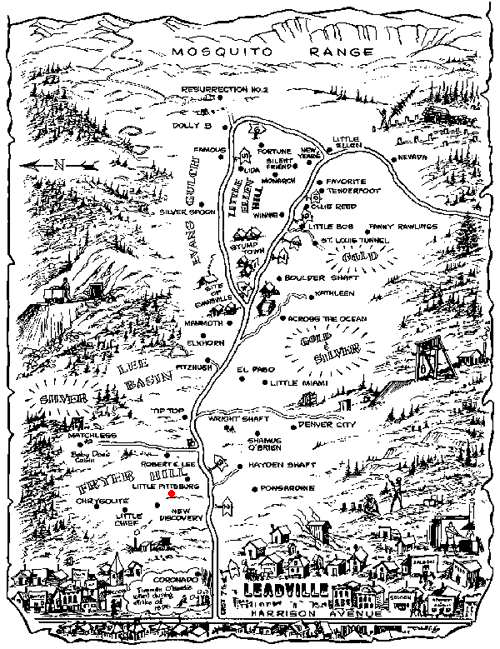
|
| 8/31/2005 |
Take This Ballot Box and Stuff It, Part II
This from the forgot-to-read-it pile:
Rocky Mountain News, March 20, 1890
SOLD LIKE CATTLE.
Voters in Spring Election Handled Like Herds of Hogs.
CHARLEY CONNOR TESTIFIES.
The court was next treated to a genuine surprise when the name of the witness was called.
Charles Conner took the stand. The witness was in town on last April election day, and was at the Eighteenth precinct polling place. He kept a saloon at the corner of Eighteenth and Lawrence then. Mr. Pence then drew a plan of the neighborhood and asked the witness how far his saloon was from the polling place. He did not know. Connor was in the saloon on election day. The witness was asked what he was doing there. He hesitated a long while and then said he refused to answer for fear it might incriminate him.
Judge Allen instructed the witness to answer under the protection of the law. He also told the lawyer to confine his questions solely to what was material in this case.
Witness was doing something in connection with the April election. With others he was furnishing slips with names and residences to men who voted on them. The witness thought Sam Emrich had written them. Sheeney Sam had delivered him forty-five at one time, forty-six at another and ninety-five at another in cigar boxes. That number they had when the polls opened in the morning.
Connor then drew on a piece of pad-paper a plan of his saloon with considerable care. He explained this to the jury. The front door was not ajar while the polls were open. The side entrance he knew had been open on election day. During the course of the day he was in the back room of the saloon and sometimes in the parlor. Men were furnished with slips of paper of this kind to vote on. Sam Emrich and a man named Jackson were inside furnishing names with him. There was a doorkeeper inside. They had a couple of doorkeepers. The men who were to vote came in sometimes three and sometimes five at a time. The doorkeepers acted under his direction some of the time. A man named Anheirer was the doorkeeper and this man stood up in the court room for identification. The man who attended to the other door was called Red Town, he did not know his proper name. Sam Emrich sometimes gave orders to the doorkeeper and other times he and Jackson did. There might have been 400 or 500 names furnished voters that day by him and others. There were more than 300 furnished. They were given straight Republican ballots and led out by men whom they had employed for this purpose. These men were Sue and Lon Blenger
[sic], Jerry Guyon, a man by the name of Allen and a man by the name of Hamm, and there were others whose names he had forgotten. He had begun this work before the polls opened. The witness
quit at 6 o'clock. Then he had gone to the polls in the Seventh ward to vote. At times he was out in the hall where plenty other men were. The witness did not know the names on the slips. He had used the larger batch of names first. Connor had used copies of the registry book made by Sam Emrich.
Earlier we ran across an article from 1897 that had Bat and Lou's pal Det. DeLue busting up polling places. Bat even got into a gunfight — from which he reportedly fled.
Sources generally have been quite plain about the Blonger Bros. political influence.
But this particular article is quite instructive about that period of time when they were still establishing themselves in Denver. Though they had first done business in Denver around 1879-80, it would not be till 1888 that Sam and Lou really settled down and committed to the growing capital city. Saloons, gambling houses, lottery shops — they were players from the start, but not czars, or kings, or overlords. No, they have been "employed" to pressure people into casting ghost ballots. Here's my take:
This guy Emerich compiles a list of names. Dead folks and such. Complicit men — undoubtedly gamblers, thugs, deadbeats and layabouts — were brought in and each handed a straight Republican ticket ballot made out in the name of one of those ghost voters. Then Lou and Sue (or whoever) "escorted" them to the polling place to assure the casting of those ballots.
So Lou and Sam are "muscle," applying pressure for this Get Out The Vote drive. Dirty work, for the hungry. Masterson was up to the same.
So they were still bit players in 1890. We know that Soapy had a hard time staying in Denver after brother Bascomb was jailed in 1895. The heat was on, and the Blongers, winning friends and influencing people all over town, were probably making life tough for him when they could. I would venture a guess that they found him too — loud. They liked things on the QT. Better for business.
And they had plenty of cash to bankroll there political machinations, since 1892, when the gold started flowing from the Forest Queen.
But not in 1890. They were tough, sure. Experienced lawmen and detectives. They'd been sharpers for some twenty-five years, and well-known as gamblers and sports. But competition was fierce.
What about Chase? He could have contended with the Blongers, as could Masterson, or a few others, for control of the lucrative bunco racket. Did they? Masterson would leave Colorado in 1901.
But here's what Linda Womack has to say about Big Ed on ReadTheWest.com:
In 1891, another Boss came into Denver's history. Robert W. Speer began his political career as a board member of the Denver Police and Fire departments. This granted Speer the authority to oversee liquor licenses and garnered him a following among Denver's underworld. Ed Chase soon became a great benefactor to Speer. The two became fast friends as each helped the other, financially and politically. Speer developed an eyes-closed policy to the gambling establishment, while Chase provided money and voters for Speer's Mayoral election. Together, the duo managed to manipulate political control of the city.
In 1904, Speer won the election to mayor in what many called the dirtiest, most fraudulent elections ever held in Denver. The Denver Times reported fictitious names gained from obituaries numbered in the thousands, as registered voters in Speer's behalf. In short, it was a winning relationship between Speer and Chase. Speer helped Chase protect his gambling enterprises, while Chase saw to it that voters cast their ballots for Speer.
The Blongers had to be in this mix somewhere, and surely profited greatly in money and power. We are led to believe the Blongers exercised great power in Denver back to the late 1880s, but that is not apparent. Chase, who seems in some subtle way "cleaner" than the Blongers, is clearly remembered today as the BMOC, and a favorite son of Denver. But the puzzle is this:
If Chase was the king of Denver gambling for some thirty years, having such political influence, and Lou was czar of Denver bunco for twenty-five years, and also a man of great political influence, why don't we see more cross-references? Why aren't they a bigger part of each other's story? Maybe they will be.
Womack says of Chase's end:
For more than seventy years to his death in 1921, Chase remained Denver's gambling czar. Shortly before his death, Chase is quoted in an interview: "All the chances are with the man who owns the house." Of his customers, he said, "I thought they might as well lose to me as to someone else, and did the best I could to accommodate them."
|
August 2005
|
Genealogy - History - Gang - Posse - Evening Review
The Grafters Club - Blonger Bros. Fake Restaurant
|
Copyright Notice: Original material copyright 2003-2021 Scott Johnson and Craig Johnson. Other copyrights may apply to materials found herein. Our primary goal is to reintroduce the Blonger Bros. to the lexicon of the Wild West. We therefore encourage the use of our research, provided due credit is given.
https://www.blongerbros.com
|
|



